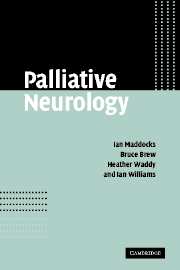Book contents
- Frontmatter
- Contents
- Foreword
- Note on drugs and abbreviations
- Section I Palliative Management
- 1 Introduction to palliation
- 2 Characteristics of palliation
- 3 Nodal points in decision-making
- 4 Common deficiencies in palliative management
- 5 Common themes in palliation practice
- Section II Major discomforts in advanced neurological illness
- Section III Major neurological conditions requiring palliation
- Section IV Ethical issues
- Section V Appendices
- Index
1 - Introduction to palliation
from Section I - Palliative Management
Published online by Cambridge University Press: 08 January 2010
- Frontmatter
- Contents
- Foreword
- Note on drugs and abbreviations
- Section I Palliative Management
- 1 Introduction to palliation
- 2 Characteristics of palliation
- 3 Nodal points in decision-making
- 4 Common deficiencies in palliative management
- 5 Common themes in palliation practice
- Section II Major discomforts in advanced neurological illness
- Section III Major neurological conditions requiring palliation
- Section IV Ethical issues
- Section V Appendices
- Index
Summary
PALLIATION, PALLIATIVE CARE AND PALLIATIVE MANAGEMENT
These related terms can be distinguished individually.
To use an analgesic for relief of pain, to inject insulin to control diabetes, to inject botulinum toxin for relief of torticollis is to palliate, to provide temporary relief.
To invoke palliative care is to call upon a newly recognized specialist practice that has evolved primarily for the care of persons with incurable cancer. It is a practice that embodies a philosophy of compassionate concern, one that recruits human and technical resources to provide a cooperating and comprehensive oversight and continuing support to relieve the totality of discomforts (physical, emotional and even spiritual).
Palliative management or the practice of palliation takes up the basic philosophy of palliative care, but brings it into fields other than cancer, encouraging the implementation of constructive palliation by any clinical speciality. Palliative management has been neglected in the modern emphasis on triumphs of cure or major disease modification, but it becomes the most appropriate approach to care when it is apparent that a patient's disease cannot be cured, or that the course of that disease cannot be modified in any significant way. The emphasis of professional attention is then on comfort and the maintenance of best possible function.
Palliative management will offer a comprehensive support that addresses the many components of discomfort (physical, emotional and spiritual) that may accompany advanced disease, and will make that support part of the responsibility of care.
- Type
- Chapter
- Information
- Palliative Neurology , pp. 3 - 11Publisher: Cambridge University PressPrint publication year: 2005



